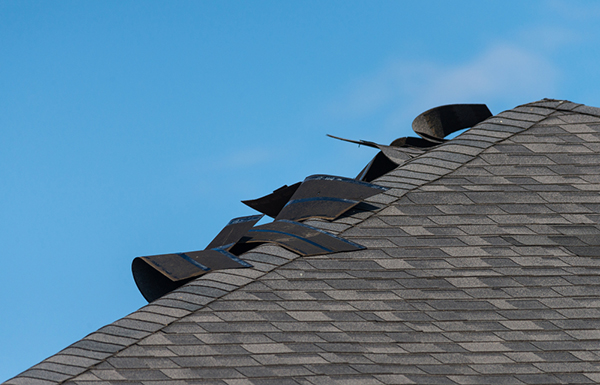Identifying Wind Damage on the Roof and Shingles
High winds are a common source of home and property damage in many areas of the U.S., whether from a thunderstorm, a derecho, or a tornado. In 2019, the National Oceanic and Atmospheric Administration collected more than 16,000 wind damage reports across the U.S.
But wind damage is not always obvious. Here are some key signs to help identify wind damage on the roof and shingles of your home.

Why the Roof?
When it comes to wind damages, the most vulnerable parts of a roof are the overhanging edge and any pieces that are already loose, such as old shingles or dangling gutters.
It's important to know that slight roof damage can start to occur when winds reach 45 miles per hour, putting already loose shingles at a greater risk. Once winds reach 58 mph, even shingles in good condition are susceptible to damage from wind speeds, broken tree limbs, and flying debris.
In addition to wind speeds, other factors compound the risk of wind damage on the roof and shingles:
- Type and age of the roofing materials.
- Building geometry and roof shape.
- Presence of flying debris.
- Quality of the roof installation.
- Height and orientation to other buildings.
Identifying Damage
In the aftermath of a storm, inspect the roof for the following signs of damage:
- Broken and missing shingles.
- Curling shingles are most often found at stress points on the roof, such as the edges, corners, near the chimney, and the ridge. When shingles are curled, they can no longer keep water from leaking through the roof. However, curved shingles are harder to spot than a missing shingle.
- Lifting shingles, which are also difficult to identify as they appear intact from the ground. When nails are loosened, and a shingle can flap or lift up, the sealant between each shingle layer may be broken.
- Missing or split chimney flashing, which is another stress point for high winds.
Never inspect your roof during a storm or if continued lightning or falling debris makes it unsafe to be outside. Conduct your inspection from the ground if you can. If you can't, practice good ladder safety, such as by only using ladders on a dry, level surface and with another person nearby. Never walk on a roof that may be wet or have loose shingles.
Another major warning sign of wind damage on the roof and shingles is water damage to your home's interior. Besides the obvious dripping ceiling, a leak may appear as brown, yellow, or gray water stains, peeling paint on the walls or ceilings, or damp rafters in the attic.
When to Call a Contractor
Even minor damage to shingles should inspire you to call a roofing contractor to inspect your home in more detail. Depending on what they find, they may give you an estimate for repairs. Keep in mind that your local roofing businesses may be busy in the aftermath of a severe storm, and you may have to wait for repairs if your situation doesn't constitute a roofing emergency or safety concern.
It's important to get any wind damage to your roof fixed as soon as possible. You'll usually save in repair costs (and headaches) by tackling small roofing issues before they turn into bigger ones.